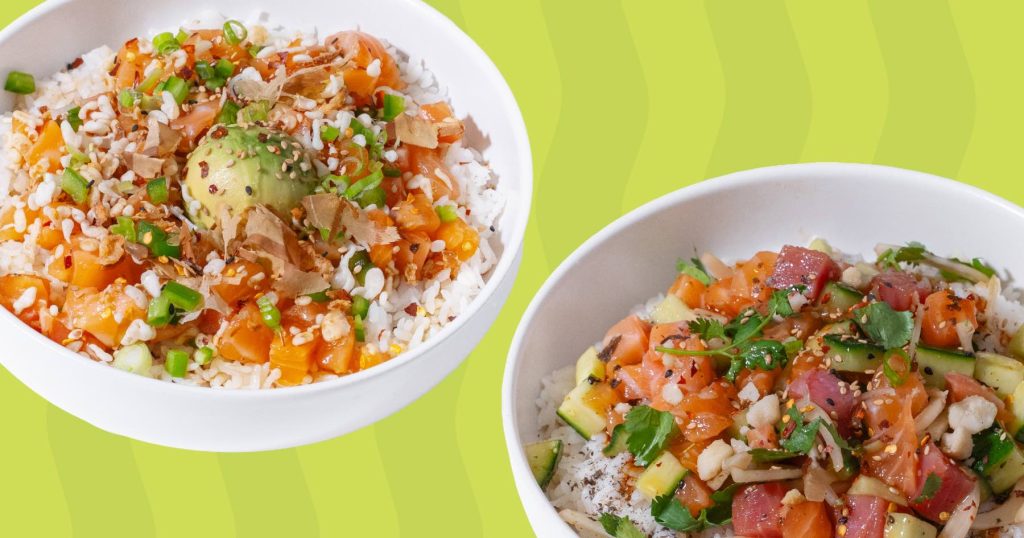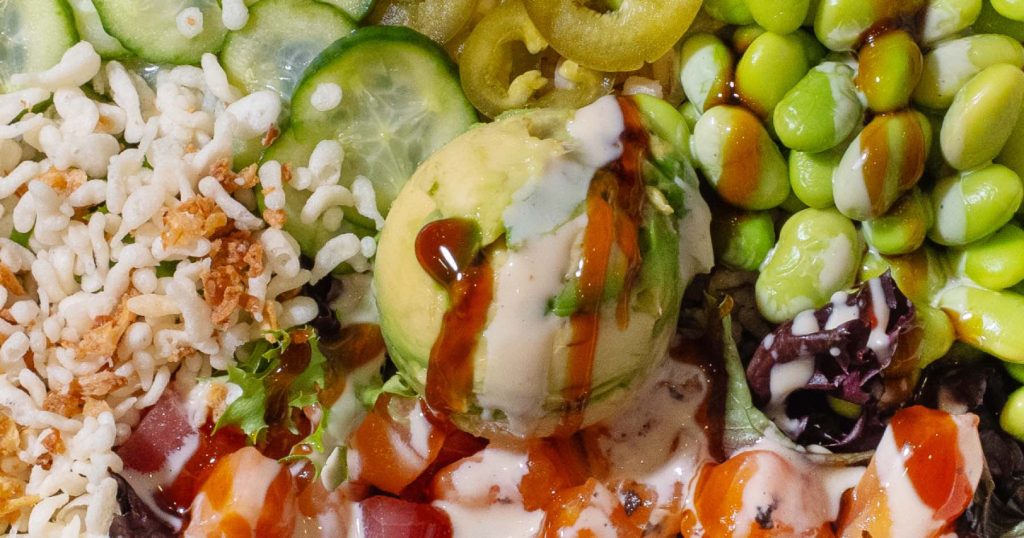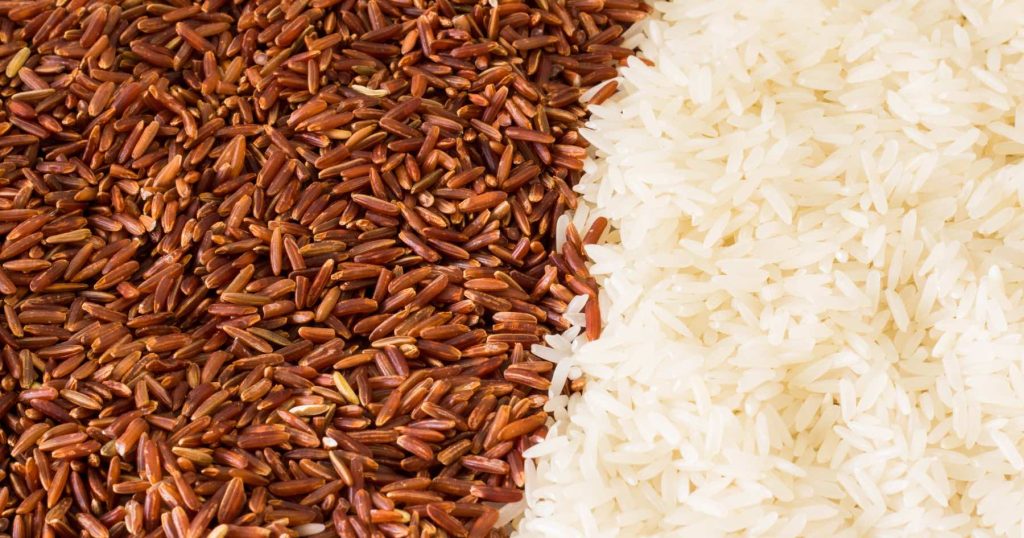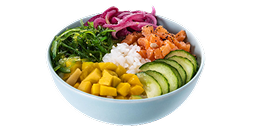You’re standing in line, bowl in hand, scanning the options. You’ve got your salmon picked out. The toppings? Locked in. But now the server looks up and asks the big question: “White or brown rice?”
You hesitate, not because you don’t care, but because you kinda do. One’s soft and familiar, the other feels like the healthier choice. But which actually fits your goals… or your cravings?
In the world of Hawaiian poké bowls, rice is the foundation. And whether you’re focused on flavor, fitness, or just finding what feels right in your body, the type of rice you choose can shape your whole experience.
Let’s unpack the difference. We’re diving into nutrition, taste, digestion, and overall vibe, so the next time you’re asked the rice question, you’ll know exactly what you want.
Nutritional Point of View: White Rice vs. Brown Rice

Let’s get into the heart of the debate: what’s really going on under the lid when it comes to nutrition?
White Rice
White rice isn’t just about simplicity. Its stripped-down form also makes it a flexible choice for a wide range of eaters. It’s:
- Low in fiber and fat, which makes it suitable for low-residue diets or individuals with sensitive digestive systems.
- Fortified in many countries, often enriched with iron, folic acid, and B vitamins after processing.
- Less allergenic than some whole grains, making it a safer option for people with food intolerances or IBS.
Because it’s clean-burning and low in complex compounds, it can be ideal for those tracking macros, managing calorie intake, or needing a neutral base that doesn’t interfere with more functional toppings like omega-rich fish or avocado.
Brown Rice
Brown rice keeps its bran layer intact, which means:
- Higher mineral content, especially magnesium, phosphorus, selenium, and zinc, is all-important for immunity, metabolism, and cell recovery.
- More phytonutrients like lignans and phenolic compounds, which have been linked to anti-inflammatory and heart-protective effects.
- Better blood sugar regulation thanks to its lower glycemic load, useful for people managing insulin sensitivity or energy crashes.
Brown rice also supports plant-based diets better due to its higher protein and fiber content. That makes it a go-to choice for vegans, vegetarians, or anyone looking to build a more complete, nutrient-dense bowl without adding meat.
Brown rice contains about 1.8g of fiber per 100g, while white rice contains only 0.4g, making brown rice significantly more filling and gut-friendly, especially for those focused on digestion or weight management.
The Nutritional Takeaway
If your focus is simplicity, performance, or dietary sensitivity, white rice is a smart, safe bet.
If you’re building a bowl for long-term health, whole-food nutrition, or plant-forward eating, brown rice checks more boxes.
Taste & Texture: What Pleases the Palate
When it comes to poké, the texture, flavor, and mouthfeel of your base can completely shift the vibe of the dish.
White Rice: Soft, Subtle, and Sauce-Friendly
White rice is known for its light, neutral taste and soft, fluffy texture. It doesn’t compete with the other ingredients in your poké bowl; instead, it supports them. Its slightly sweet flavor and absorbent nature make it ideal for bowls with bold sauces like spicy mayo, ponzu, or sesame soy. When paired with raw fish like tuna or salmon, white rice offers a clean, smooth mouthfeel that enhances the silky texture of the protein without overwhelming it. If you’re looking for a base that disappears into the background and lets the toppings take the lead, white rice is the clear choice.
Brown Rice: Nutty, Chewy, and Full of Flavor
Brown rice brings more character to the bowl. Its earthy, slightly nutty flavor and chewy texture add depth to each bite, making it more than just a filler. Because it retains the bran and germ, brown rice has a denser feel and a more complex flavor than white rice. It works particularly well with cooked or grilled proteins such as miso-glazed salmon, shrimp, or tofu. While brown rice doesn’t soak up sauces as readily as white rice, it holds its shape and adds a wholesome, rustic balance, especially if you’re aiming for a more hearty, fiber-rich experience.
Digestion & Satiety: How Your Body Reacts

The rice you choose impacts how your body processes and responds to your meal long after the last bite.
Brown Rice: The Slow Burner
Brown rice is a whole grain, meaning it retains its bran and germ layers. That translates to more fiber, which slows down digestion and helps you feel fuller for longer. This slow-release energy curve is ideal for sustained satiety, curbing cravings, and avoiding energy crashes. It’s especially useful if you’re grabbing a poké bowl as a hearty lunch or dinner that needs to keep you going for hours.
One study found that meals containing brown rice improved satiety and post-meal fullness compared to white rice, thanks to the fiber and nutrient density.
White Rice: Quick Fuel for Active Bodies
White rice digests faster. It skips the fiber-heavy outer layers and heads straight into your system, providing a quick boost of glucose, ideal for replenishing glycogen stores after intense exercise. For athletes, gym-goers, or anyone needing fast, light recovery, white rice offers efficient post-workout fuel without weighing you down.
Context Is Key
- Post-workout or pre-training? Go for white rice, it’s lighter, gentler on the stomach, and gets to work fast.
- Working a desk job or eating a big lunch? Brown rice will keep you satisfied and energized without the afternoon slump.
Which One Wins?
If you’re hoping for a definitive answer, here’s the truth: there isn’t one. Choosing between white rice and brown rice isn’t about picking a winner; it’s about picking what you need, when you need it.
- Craving something light, fluffy, and fast to digest after a tough workout? White rice steps up with its quick-burning energy.
- Looking for slow, steady fuel to get you through your afternoon or support your wellness goals? Brown rice delivers with fiber, nutrients, and staying power.
Your body isn’t static, neither should your bowl be. The beauty of poké is how customizable it is. Try both. Switch it up. Tune in to how your body responds. You might find that your ideal bowl looks different from one day to the next
Conclusion
At the end of the day, choosing between white rice and brown rice isn’t about right or wrong; it’s about what feels good in your body, fits your lifestyle, and satisfies your taste. Some days you might crave the clean simplicity of white rice. Other days, the nutty bite of brown rice hits just right. And honestly? That flexibility is the beauty of a great poké bowl.
At Olu Olu Poké, you don’t have to choose just one way to eat well. Whether you’re fueling up after a workout, grabbing a light lunch, or simply treating yourself to a nourishing bowl, you get to call the shots. Fresh ingredients. Fast service. Custom combinations. And yes, both kinds of rice.
Try your next bowl at Olu Olu and taste the difference.
FAQs
1. Is brown rice always healthier than white rice?
Not necessarily. Brown rice has more fiber and nutrients, but white rice is easier to digest, making it a great choice for quick energy, especially post-workout.
2. Which rice option is better for weight management?
Brown rice digests more slowly, which helps you feel full longer. That makes it a smart pick if you’re watching portions or managing hunger.
3. What rice does Olu Olu Poké offer?
You can choose between white rice and brown rice, or even opt for rice-free options if you’re cutting carbs.
4. Does white rice spike blood sugar more than brown rice?
Yes. White rice has a higher glycemic index, so it raises blood sugar more quickly. Brown rice offers a steadier release of energy.
5. Can I mix white and brown rice in one bowl?
Absolutely! If you want the softness of white rice and the fiber of brown, ask the team at Olu Olu to mix them up.











